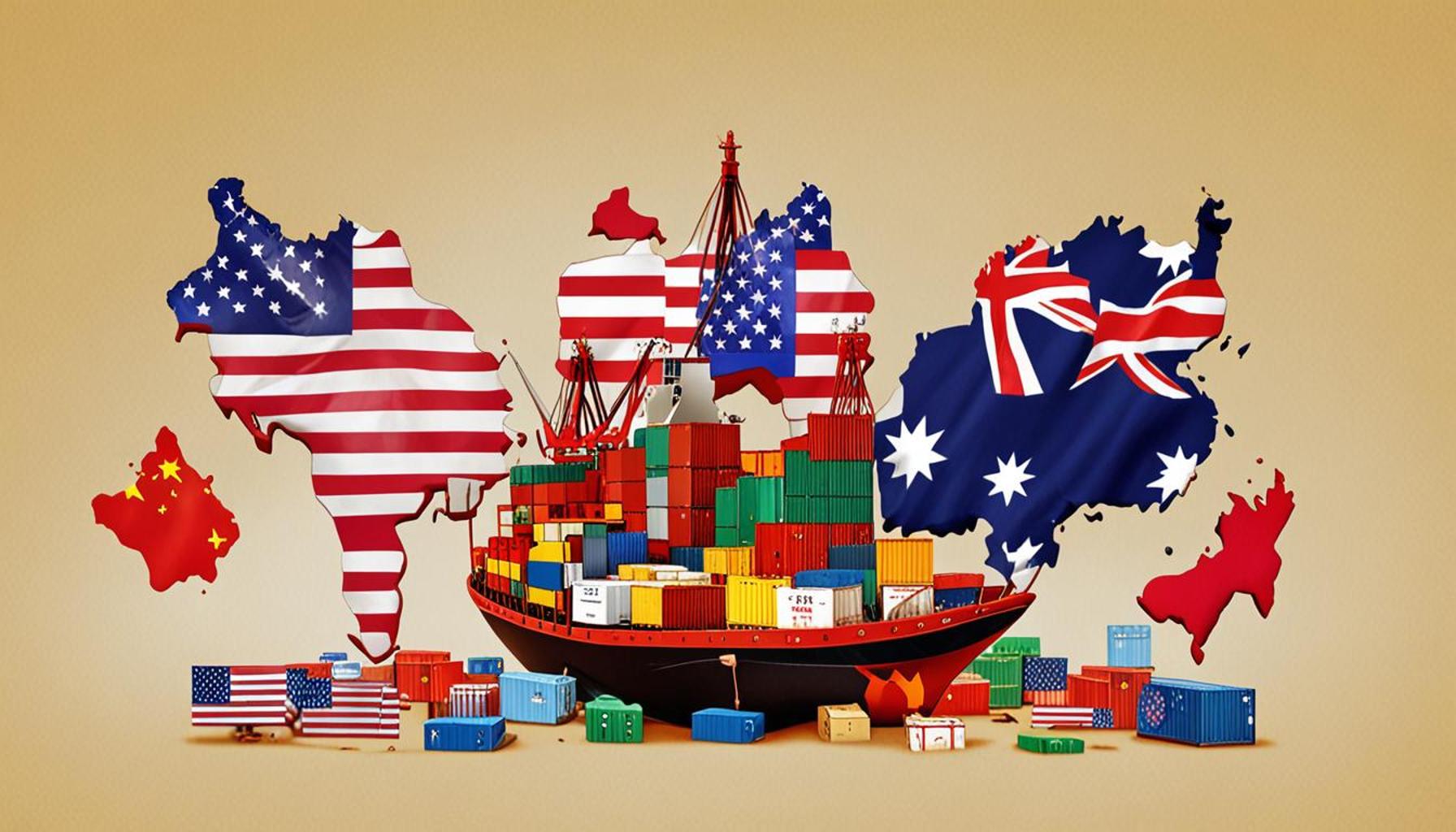The influence of the trade war between the US and China on the Australian economy

Understanding the Economic Ties Between Australia, the US, and China
The economic landscape of Australia is inextricably linked to the ongoing trade war between the United States and China. This conflict does not merely reside in political boardrooms; it affects every Australian through interconnected trade relationships, investments, and consumer behavior. By delving deeper into these dynamics, we see that both nations significantly influence Australia’s economic stability and growth potential.
How Trade Relationships Shape Australia
Export markets: Australia’s economy thrives on its export capabilities, and in this arena, China plays a pivotal role as Australia’s largest trading partner. According to recent statistics, over 30% of Australia’s exports, including iron ore and coal, head to China. Conversely, the United States is another vital market, particularly for Australian agricultural products such as wine and beef. The trade tensions can lead to tariffs that make these goods less competitive in international markets, ultimately affecting Australian farmers’ livelihoods.
Investment flows: Foreign direct investment (FDI) from both countries also marks a significant part of the Australian economy. The US firms have heavily invested in technology and infrastructure in Australia, while Chinese investment largely focuses on natural resources. Changes in the trade policies between the US and China can prompt shifts in these investments, impacting sectors critical to Australia’s future, like renewable energy and telecommunications.
The Ripple Effects of Trade Conflicts
Consumer confidence: The sentiments of consumers are incredibly sensitive to global market fluctuations. For instance, during periods of heightened trade tensions, many Australian households may feel uncertain about job security, leading to more cautious spending behavior. This scenario can slow down economic growth as businesses face reduced demand, reflecting a broader trend in economic activity.
Commodity prices: Since Australia heavily relies on exporting commodities like iron ore and coal, any trade restrictions can dramatically influence prices. For example, if the US imposes tariffs on Chinese goods, China may retaliate against Australia’s resource exports, leading to declines in commodity prices. Lower prices can significantly reduce revenue for Australian mining companies, impacting government budgets and jobs within the sector.
Supply chain disruptions: Modern economies are interconnected, with many Australian companies depending on imports from both the US and China. Increased tariffs can disrupt these supply chains, leading to higher costs and delivery delays. For example, a business in Australia that relies on electronics manufactured in China could face delays and increased expenses if tariffs make imports more expensive, ultimately affecting their pricing and competitiveness.
Overall, the challenges posed by these trade tensions can threaten Australia’s economic stability and growth. However, they also offer unique opportunities to diversify trade partnerships and strengthen ties with other nations, reducing reliance on any single market. In the next sections, we will delve into specific case studies and examples that illustrate these complex dynamics in action, along with what they mean for the average Australian. Understanding these nuances is essential for informed decision-making as the global trade landscape continues to evolve.
Examining the Consequences of Trade Policies
The ongoing trade war between the United States and China has potential ramifications that extend well beyond the borders of these two economic giants, impacting countries like Australia. Understanding how shifts in trade policies filter down to the Australian economy requires a closer look at several key areas, including export opportunities, investment patterns, and consumer behavior.
Export Opportunities and Vulnerabilities
Australia’s reliance on exporting natural resources makes it vulnerable to the outcomes of the US-China trade war. As mentioned earlier, a significant portion of Australian exports head to China, which is essential to our economy. Any alteration in trade agreements between the US and China can create ripple effects that result in less demand for Australian goods. For instance, if China feels the strain of tariffs on US imports, it might reduce its imports of Australian resources to manage costs. This potential scenario can lead to:
- Job losses: Local workers in industries like mining and agriculture may face layoffs if export volumes decline.
- Investment pullback: Companies reliant on exporting goods might scale back expansion plans, opting instead for caution amid uncertain revenue.
- Currency fluctuations: A drop in demand for Australian exports could lead to a weaker Australian dollar, making imports more expensive and inflationary pressures likely.
Shifts in Investment Patterns
Both the US and China are significant sources of foreign direct investment in Australia. However, these investments are tightly bound to the trade policies that govern exchanges between the two countries. For example, if tariffs lead to a slowdown in the Chinese economy, Chinese investors may retreat from Australian markets to protect their capital. This could have several implications:
- Sectoral impacts: Sectors like real estate and mining, which have seen substantial Chinese investment, could face declines in financial backing, affecting their growth potential.
- Reduced confidence: Australian businesses may hesitate to invest further in expansion projects, fearing reduced market viability.
- Policy reforms: The government might introduce policies aimed at attracting investment from other countries, diversifying the sources of foreign direct investment.
Consumer Behavior: A Barometer of Economic Health
In the face of global uncertainties, consumer confidence often reflects the underlying economic health within Australia. During periods of trade tension, Australians may become more apprehensive about their personal finances, leading to more cautious spending habits. Key aspects impacting consumer behavior include:
- Job security concerns: Trade conflicts can lead to layoffs or reduced hours, making consumers hesitant to spend money on non-essential items.
- Price increases: Higher tariffs often lead businesses to pass on the costs to consumers, resulting in increased prices for everyday goods.
- Shift in preferences: Consumers may start opting for local products instead of imports, pushing Australian businesses to adapt quickly to changing market demands.
Ultimately, a comprehensive understanding of how the US-China trade war influences the Australian economy is essential for safeguarding against potential crises while capitalising on emerging opportunities. Looking ahead, it will become increasingly crucial for Australia to navigate this complex global landscape, ensuring that its economic strategies remain resilient and adaptive.
Managing the Economic Ripple Effects
As Australia grapples with the ongoing implications of the US-China trade war, it is essential to consider how the Australian government and businesses can adapt to mitigate adverse effects and harness new opportunities. Several strategies can be explored to navigate this complex landscape and safeguard the economy.
Diversifying Trade Partners
In light of uncertainty surrounding trade relations with both the US and China, one proactive strategy for Australia is to diversify its trade partnerships. By seeking new markets for exports, Australia can reduce its over-reliance on China and the US. For instance, countries like India and Germany have emerged as potential alternatives for trade growth. Diversification can lead to:
- Expanded markets: Australia could benefit from new trade agreements and partnerships, which may enhance access to emerging markets, thus reducing vulnerability to disruptions caused by the trade war.
- Increased resilience: By not putting all its eggs in one basket, relying on a range of partners can help stabilize revenue streams in times of global uncertainty.
- Technology and innovation: Engaging with new markets can also promote the exchange of ideas and technology, benefiting sectors such as agriculture and technology.
Investment in Local Industries
The trade war not only stresses external trade relations but also provides a unique opportunity to develop internal strength. An increased focus on investing in local industries, especially those that can replace imports, might help buffer the economy against external shocks. This can be visible through:
- Support for small businesses: Government initiatives aimed at encouraging local entrepreneurship can drive innovation and job creation, leading to a more robust local economy.
- Sectoral development: Investing in industries such as renewable energy and advanced manufacturing can reduce dependence on imported goods and enhance the sustainability of the Australian economy.
- Training and skills programs: Strengthening the workforce through education and training initiatives will better prepare Australians for jobs in emerging sectors, making for a competitive economy.
Strengthening Bilateral Relations
While facing the challenges posed by the US-China trade war, Australia has an opportunity to fortify its bilateral relationships with other countries. Building closer ties with nations in the Asia-Pacific region can support trade flows and economic growth. Some pathways include:
- Trade agreements: Actively pursuing new free trade agreements with countries in the Asia-Pacific can reduce barriers, making it easier for Australian goods and services to reach new markets.
- Partnerships and collaborations: Engaging in collaborative research and development initiatives, particularly with countries like Japan and South Korea, can drive innovation and open pathways for new technologies.
- Educational exchange: Enhancing educational ties through exchange programs can facilitate mutual understanding, strengthen diplomatic relations, and foster future economic partnerships.
The Australian economy stands at a crossroads as it navigates the effects of the US-China trade war. Taking proactive steps such as diversifying trade, investing in local industries, and strengthening bilateral relations can help ensure that the economy remains resilient and adaptable. By preparing for potential shocks while harnessing new opportunities, Australia can work towards sustaining growth and stability amid global uncertainties.
Conclusion
The trade war between the US and China presents significant challenges and opportunities for the Australian economy. As we have explored, the repercussions of this conflict extend beyond the borders of the two largest economies, affecting nations like Australia that are closely linked to their trade dynamics. Nevertheless, Australia’s ability to adapt through diversification of trade partners, increased investment in local industries, and strengthening relationships in the Asia-Pacific region can serve as critical strategies to mitigate the negative impacts.
By actively seeking to expand its trade network, Australia can safeguard itself from over-reliance on any single market, particularly in the face of ongoing global uncertainties. Additionally, fostering local industries not only stimulates economic growth but also creates jobs and encourages innovation domestically. Emphasizing sectoral development and investing in a skilled workforce are fundamental steps toward a more resilient economy.
Finally, as Australia solidifies its bilateral relations and partnerships, especially within the Asia-Pacific, it can enhance its standing in global trade. Navigating through these turbulent times requires a forward-thinking approach that capitalizes on new opportunities while preparing for challenges. In essence, Australia’s response to the US-China trade war could shape the trajectory of its economic future, ensuring that it remains competitive and robust despite the shifting global landscape.

James Carter is a financial writer and advisor with expertise in economics, personal finance, and investment strategies. With years of experience helping individuals and businesses make complex financial decisions, James offers practical insight and analysis. His goal is to give readers the knowledge they need to achieve financial success.






